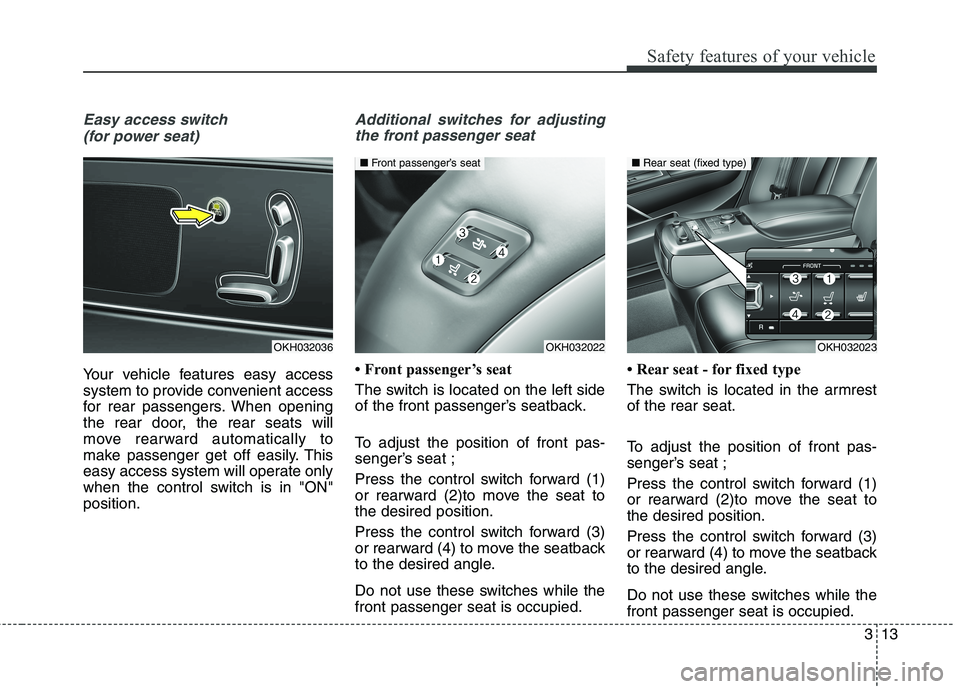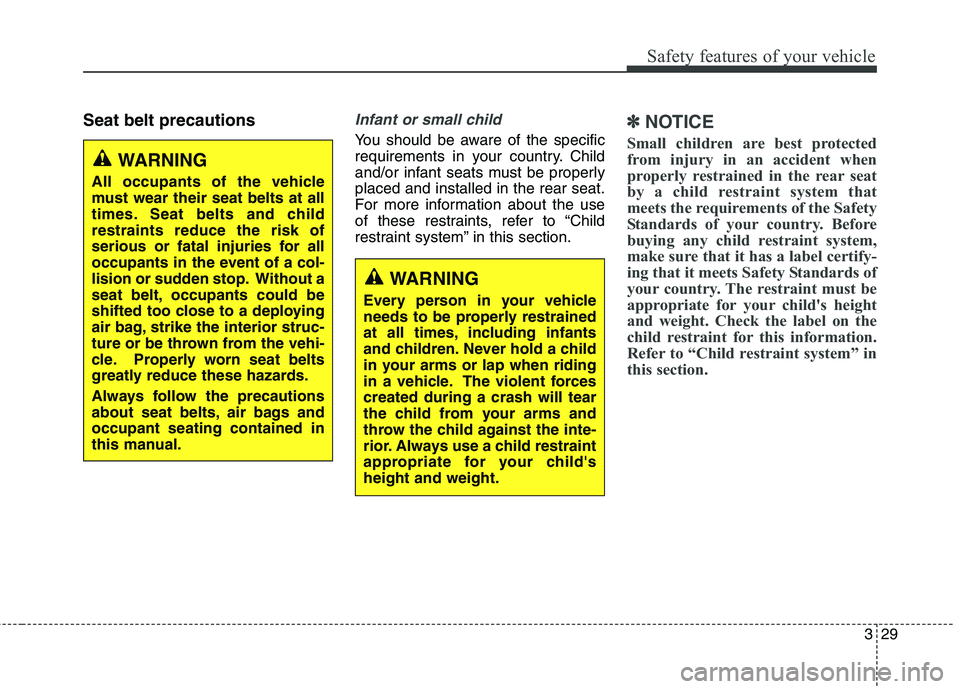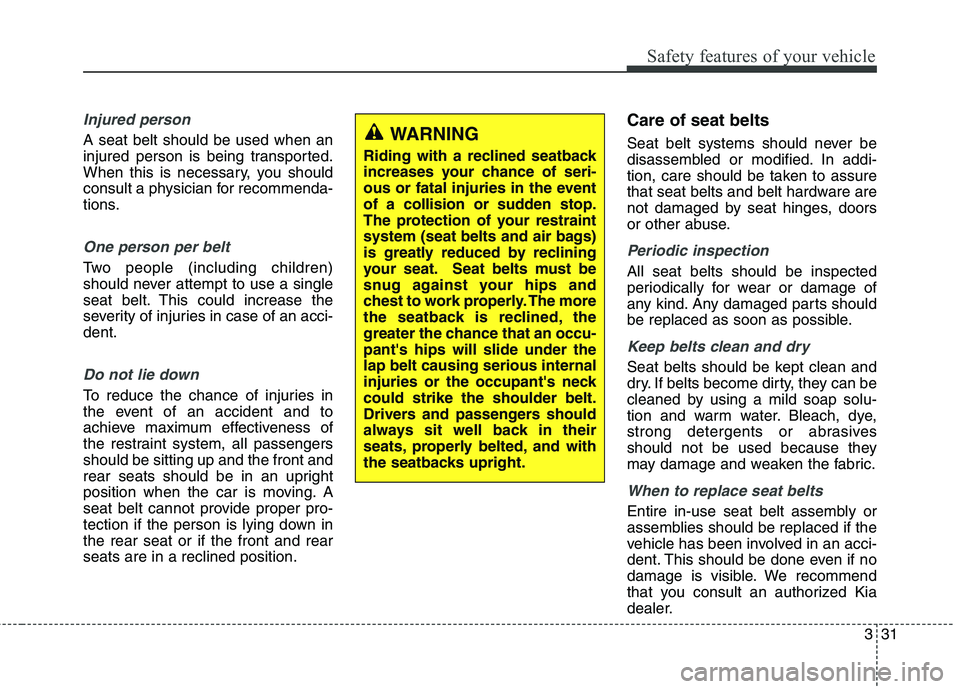2013 KIA QUORIS seats
[x] Cancel search: seatsPage 16 of 485

Safety features of your vehicle
Seats . . . . . . . . . . . . . . . . . . . . . . . . . . . . . . . . . . . . . . 3-2• Front seat adjustment . . . . . . . . . . . . . . . . . . . . . . . . . . 3-4 Driver position memory system . . . . . . . . . . . . . 3-7
Headrest-front . . . . . . . . . . . . . . . . . . . . . . . . . . . 3-8
Rear seat adjustment . . . . . . . . . . . . . . . . . . . . . 3-12
Seat belts . . . . . . . . . . . . . . . . . . . . . . . . . . . . . . . . . 3-19 Seat belt restraint system . . . . . . . . . . . . . . . . . 3-19
Seat belt warning . . . . . . . . . . . . . . . . . . . . . . . . 3-21
Pre-tensioner seat belt . . . . . . . . . . . . . . . . . . . . 3-25
Pre-safe seat belt (psb) . . . . . . . . . . . . . . . . . . . 3-28
Seat belt precautions . . . . . . . . . . . . . . . . . . . . . 3-29
Child restraint system . . . . . . . . . . . . . . . . . . . . . . 3-32 Using a child restraint system . . . . . . . . . . . . . 3-34
Air bag - supplemental restraint system . . . . . . . 3-43 How does the air bag system operate . . . . . . . 3-44
Do not install a child restraint on the front
passenger's seat . . . . . . . . . . . . . . . . . . . . . . . . 3-45
Air bag warning light . . . . . . . . . . . . . . . . . . . . 3-46
Srs components and functions . . . . . . . . . . . . . 3-47
Driver's and passenger's front air bag . . . . . . 3-50
Side air bag . . . . . . . . . . . . . . . . . . . . . . . . . . . . . 3-54
Curtain air bag . . . . . . . . . . . . . . . . . . . . . . . . . 3-55
. 3-57 Srs care . . . . . . . . . . . . . . . . . . . . . . . . . . . . . . . . 3-62
Additional safety precautions . . . . . . . . . . . . . . 3-63
Air bag warning label . . . . . . . . . . . . . . . . . . . . 3-64
3
Page 17 of 485

Safety features of your vehicle
2
3
Driver’s seat
(1) Forward and rearward (2) Seat cushion length
(3) Seatback angle(4) Headrest height
(5) Driver position memory system
(6) Lumbar support
Front passenger’s seat
(7) Forward and rearward
(8) Seatback angle(9) Headrest height Rear seat
(10) Forward and rearward
(11) Easy access button
(12) Front passenger’s seat forward
and rearward*
(13) F ront passenger’s seat back
angle*
(14) Lumbar support
(15) Rear control lock button
(16) Front passenger’s seat walk in button*
SEATS
OKH032001L
Page 18 of 485

33
Safety features of your vehicle
(17) Relaxation mode button*(Front passenger's seat andrear seat are operated simulta- neously)
(18) Armrest
*: if equipped
WARNING - Loose objects
Loose objects in the driver’s
foot area could interfere with
the operation of the foot pedals,
possibly causing an accident.
Do not place anything under the
front seats.
WARNING - Driver
responsibility for passen-
gers
Riding in a vehicle with the
seatback reclined could lead to
serious or fatal injury in an acci-
dent. If a seat is reclined during
an accident, the occupant’s
hips may slide under the lap
portion of the seat belt applying
great force to the unprotected
abdomen. Serious or fatal inter-
nal injuries could result. The
driver must advise the passen-
ger to keep the seatback in an
upright position whenever the
vehicle is in motion.WARNING
Do not use a aftermarket sitting cushion that reduces frictionbetween the seat and passen-
ger. The passenger's hips may
slide under the lap portion ofthe seat belt during an accident
or a sudden stop. Serious orfatal internal injuries couldresult because the seat belt
can't operate normally.
1KMN3661
WARNING - Driver’s seat
Never attempt to adjust the seat while the vehicle is mov-
ing. This could result in loss
of control, and an accident
causing death, serious injury,
or property damage.
(Continued)
Page 23 of 485

Safety features of your vehicle
8
3
Recalling positions from memory
1. Shift the shift lever into P while the
engine start/stop button is ON.
2. To recall the position in memory, press the desired memory button
(1 or 2). The system will beep
once, then the driver seat, outside
rearview mirror and steeringwheel will automatically adjust to
the stored positions.
Adjusting one of the control knobs for
the driver seat, outside rearview mir-
ror and steering wheel while the sys-tem is recalling the stored positions
will cause the movement for that
component to stop and move in thedirection that the control knob is
moved. Other components will con-
tinue to the recalled position.Easy access function
The steering wheel will move away
from the driver and the seat will
move rearward, when the engine
start/stop button is turned to the OFF
position and front driver’s door isopened.
The steering wheel will move toward
the driver and the seat will move for-
ward, when the engine start/stop but-
ton is turned to the ACC position or
when you insert the smart key into
the smart key holder with the shift
lever in the P position.
✽✽ NOTICE
You can activate or deactivate the
easy access function in the instru-
ment cluster.
If you want detailed informations,
refer to the chapter 4.
Headrest-front
The driver's and front passenger's seats are equipped with a headrest
for the occupant's safety and com-
for t.
The headrest not only provides com-
fort for the driver and front passen-
ger, but also helps to protect the
head and neck in the event of a colli-sion.
WARNING
Use caution when recalling
adjustment memory while sit-
ting in the vehicle. Push the seat
position control knob to the
desired position immediately if
the seat moves too far in anydirection.
OBH038075L
Page 28 of 485

313
Safety features of your vehicle
Easy access switch (for power seat)
Your vehicle features easy access
system to provide convenient access
for rear passengers. When opening
the rear door, the rear seats will
move rearward automatically to
make passenger get off easily. This
easy access system will operate only
when the control switch is in "ON"position.
Additional switches for adjustingthe front passenger seat
Front passenger’s seat
The switch is located on the left side
of the front passenger’s seatback.
To adjust the position of front pas-
senger’s seat ;
Press the control switch forward (1)
or rearward (2)to move the seat tothe desired position.
Press the control switch forward (3)
or rearward (4) to move the seatback
to the desired angle.
Do not use these switches while the front passenger seat is occupied. Rear seat - for fixed type
The switch is located in the armrest of the rear seat.
To adjust the position of front pas-
senger’s seat ;
Press the control switch forward (1)
or rearward (2)to move the seat tothe desired position.
Press the control switch forward (3)
or rearward (4) to move the seatback
to the desired angle.
Do not use these switches while the front passenger seat is occupied.
OKH032036OKH032022
■
Front passenger’s seat
OKH032023
■ Rear seat (fixed type)
Page 44 of 485

329
Safety features of your vehicle
Seat belt precautionsInfant or small child
You should be aware of the specific
requirements in your country. Child
and/or infant seats must be properlyplaced and installed in the rear seat.
For more information about the use
of these restraints, refer to “Child
restraint system” in this section.
✽✽NOTICE
Small children are best protected
from injury in an accident when
properly restrained in the rear seat
by a child restraint system that
meets the requirements of the Safety
Standards of your country. Before
buying any child restraint system,
make sure that it has a label certify-
ing that it meets Safety Standards of
your country. The restraint must be
appropriate for your child's height
and weight. Check the label on the
child restraint for this information.
Refer to “Child restraint system” in
this section.
WARNING
All occupants of the vehicle
must wear their seat belts at all
times. Seat belts and childrestraints reduce the risk of
serious or fatal injuries for all
occupants in the event of a col-
lision or sudden stop. Without a
seat belt, occupants could be
shifted too close to a deploying
air bag, strike the interior struc-
ture or be thrown from the vehi-
cle. Properly worn seat belts
greatly reduce these hazards.
Always follow the precautions
about seat belts, air bags andoccupant seating contained in
this manual.
WARNING
Every person in your vehicle
needs to be properly restrained
at all times, including infants
and children. Never hold a child
in your arms or lap when riding
in a vehicle. The violent forcescreated during a crash will tear
the child from your arms and
throw the child against the inte-
rior. Always use a child restraint
appropriate for your child'sheight and weight.
Page 46 of 485

331
Safety features of your vehicle
Injured person
A seat belt should be used when an
injured person is being transported.
When this is necessary, you should
consult a physician for recommenda-
tions.
One person per belt
Two people (including children)
should never attempt to use a single
seat belt. This could increase the
severity of injuries in case of an acci-dent.
Do not lie down
To reduce the chance of injuries in
the event of an accident and to
achieve maximum effectiveness of
the restraint system, all passengersshould be sitting up and the front and
rear seats should be in an upright
position when the car is moving. A
seat belt cannot provide proper pro-
tection if the person is lying down inthe rear seat or if the front and rearseats are in a reclined position.Care of seat belts
Seat belt systems should never be
disassembled or modified. In addi-
tion, care should be taken to assure
that seat belts and belt hardware are
not damaged by seat hinges, doors
or other abuse.
Periodic inspection
All seat belts should be inspected
periodically for wear or damage of
any kind. Any damaged parts should
be replaced as soon as possible.
Keep belts clean and dry
Seat belts should be kept clean and
dry. If belts become dirty, they can be
cleaned by using a mild soap solu-
tion and warm water. Bleach, dye,
strong detergents or abrasives
should not be used because they
may damage and weaken the fabric.
When to replace seat belts
Entire in-use seat belt assembly or
assemblies should be replaced if the
vehicle has been involved in an acci-
dent. This should be done even if no
damage is visible. We recommend
that you consult an authorized Kia
dealer.
WARNING
Riding with a reclined seatback
increases your chance of seri-
ous or fatal injuries in the event
of a collision or sudden stop.
The protection of your restraint
system (seat belts and air bags)
is greatly reduced by reclining
your seat. Seat belts must be
snug against your hips and
chest to work properly. The more
the seatback is reclined, the
greater the chance that an occu-pant's hips will slide under thelap belt causing serious internal
injuries or the occupant's neckcould strike the shoulder belt.
Drivers and passengers should
always sit well back in their
seats, properly belted, and with
the seatbacks upright.
Page 47 of 485

Safety features of your vehicle
32
3
CHILD RESTRAINT SYSTEM
Children riding in the car should sit in
the rear seat and must always be
properly restrained to minimize the
risk of injury in an accident, sudden
stop or sudden maneuver. According
to accident statistics, children are
safer when properly restrained in therear seats than in the front seat.
Larger children not in a child restraintshould use one of the seat belts pro-vided.
You should be aware of the specific
requirements in your country. Child
and/or infant safety seats must be
properly placed and installed in the
rear seat. You must use a commer-
cially available child restraint systemthat meets the requirements of the
Safety Standards of your country.
Child restraint systems are designed
to be secured in vehicle seats by lap
belts or the lap belt portion of a
lap/shoulder belt, or by a tether
anchor and/or ISOFIX anchors. Children could be injured or killed in
a crash if their restraints are not
properly secured. For small children
and babies, a child seat or infant seat
must be used. Before buying a par-
ticular child restraint system, make
sure it fits your car seat and seat
belts, and fits your child. Follow all
the instructions provided by the man-
ufacturer when installing the child
restraint system.
WARNING
A child restraint system must be placed in the rear seat.
Never install a child or infant
seat on the front passenger's
seat. Should an accidentoccur and cause the passen-
ger-side air bag to deploy, it
could severely injure or kill an
infant or child seated in an
infant or child seat. Thus only
use a child restraint in the
rear seat of your vehicle.
(Continued)
(Continued)
A seat belt or child restraintsystem can become very hot
if it is left in a closed vehicle
on a sunny day, even if theoutside temperature does not
feel hot. Be sure to check the
seat cover and buckles before
placing a child there.
When the child restraint sys- tem is not in use, store it in
the luggage area or fasten itwith a seat belt so that it will
not be thrown forward in the
case of a sudden stop or anaccident.
Children may be seriously injured or killed by an inflating
air bag. All children, even
those too large for child
restraints, must ride in therear seat.